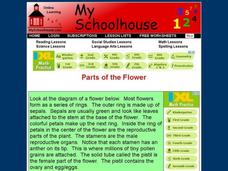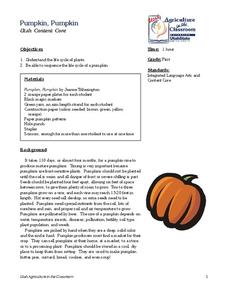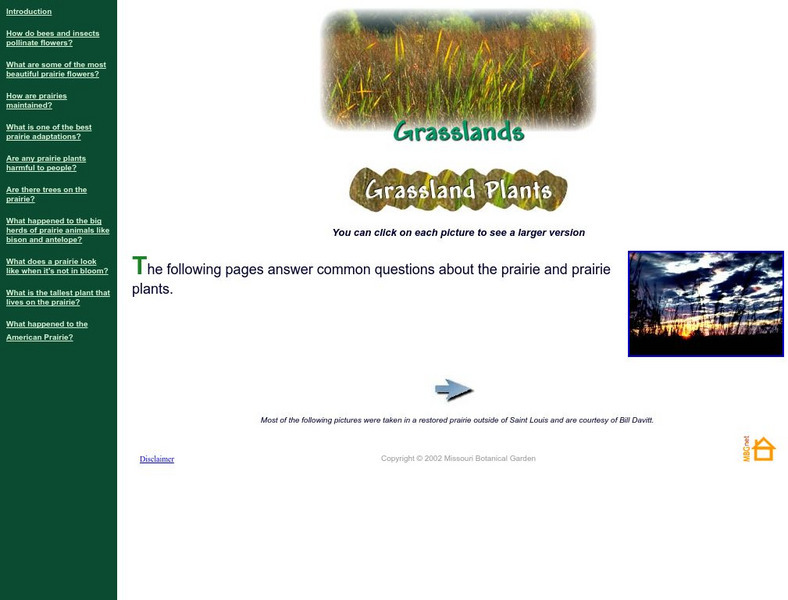English Worksheets Land
A Tale of Two Gardens
Gardening is fun, no matter what you're growing. A reading comprehension activity encourages learners to compare and contrast two gardens that grow different items.
National Wildlife Federation
Habitat Web
Young scientists weave together an understanding of ecosystems with this fun collaborative activity. Taking on the roles of different living and non-living elements of specific habitats, learners use a ball of yarn to create...
Curated OER
My Own Backyard
Scholars create a drawing of their own backyards. They will use a visualization technique to sketch their own backyard onto construction paper using oil pastels. Guiding questions are given along with materials for the project....
Curated OER
Symbiosis: Help, Hinder or Destroy
Use background information and vocabulary to familiarize your students with the concept of symbiosis and the role agriculture plays in the shared relationship. They then write the vocabulary in their lab books or journals, and read the...
Curated OER
Will It Grow?
Fifth graders conduct experiments involving plants. In this science lesson, 5th graders design an experiment involving plants. Students use the scientific method to design their experiments.
Curated OER
Flower Dissection
Students dissect three different flowers and compare and contrast them. In this flowers lesson plan, students learn about the flower anatomy and then dissect their own flowers.
Curated OER
Profit From Pumpkins
Third graders cut open a pumpkin. In this math lesson plan, 3rd graders complete the worksheet "From Seed to Pumpkin" and then clean out their pumpkins to see how many seeds are in it.
Curated OER
Fun with Plants Flower Power
Students understand the parts of the flower. In this flower instructional activity, students perform experiments to see where seeds come from. Students complete a data sheet about the experiment. Students understand the terms pistil and...
Curated OER
Locating Echo
Students read the book The Adventure of Echo the Bat. In this animal science lesson plan, students read the book and create a chart labeled "Land Feature," "Habitat," and "Food." Students fill in the table according to where the...
Curated OER
Brays Bayou Spiderwort Genetic Study
Students formulate hypothesis based upon data gathered by examining possible crosses of spiderworts using Punnett squares. They present explanations for physiological adaptations of spiderworts that resulted from interactions within the...
Curated OER
CONNECTIONS
Students study the interdependence of an ecosystem that allows it to sustain itself. They examine the Western lowland gorillas for an example.
Curated OER
Parts of the Flower
In this biology worksheet, students examine a diagram of a flower and read a selection that describes all of the parts including the petals, the stamen, the anther, and the sepals. They answer 11 on-line fill in the blank questions using...
Curated OER
Flowering Plants
Students conduct online research to investigate gardening and landscaping tips. They determine how they can help beautify their homes and neighborhoods.
Curated OER
Pumpkin, Pumpkin
First graders understand that pumpkins grow slowly over several months. In this pumpkin instructional activity, 1st graders listen to the book Pumpkin, Pumpkin and recall the sequence of the pumpkin life cycle. Students create pumpkin...
Curated OER
Fun with Flowers
Learners make observations of flowers. In this life science lesson, students look at flowers, then draw and color their favorite flowers. Lesson includes extension activities.
Curated OER
Cinderella: Literacy Skills Packet
For this Cinderella worksheet packet, students can practice their literacy skills by unscrambling vocabulary words, doing a crossword puzzle, completing a story sequence activity, answering eight short answer questions, and completing...
Curated OER
Forest Food Web
Students explore the elements of a forest ecosystem. They examine the elements needed to form a forest food web. Students construct and describe food webs that include nonliving elements of the ecosystem.
Smithsonian Institution
Smithsonian Education: Partners in Pollination
Here is a three-part lesson plan on the plant and animal relationship in respect to pollination.
PBS
Pbs: Nova: A Plant With Smarts
Not only are orchids tricky when it comes to being pollinated, they also have some tricks that help them survive in a competitive environment. Discover how orchids outwit insects to reproduce and how they have adapted to survive in their...
Other
Unusual Pollination: Bee Orchid
Some flowers have developed adaptations that lure insects to them for pollination. Visit this website to learn about the very unusual adaptations of the bee orchid.
Missouri Botanical Garden
Missouri Botanical Garden: Grassland Plants
This site from the Missouri Botanical Garden explores some commonly asked questions about the prairie and prairie plants.






















